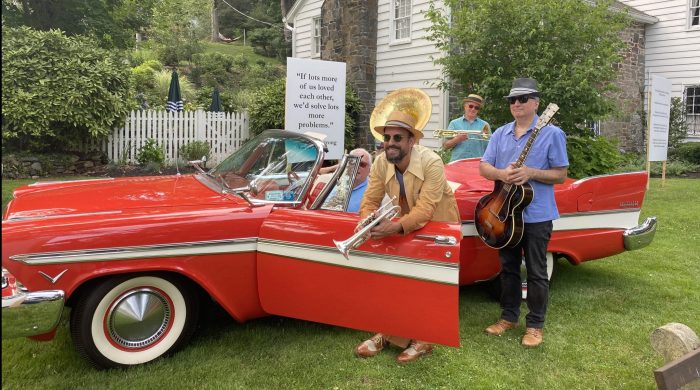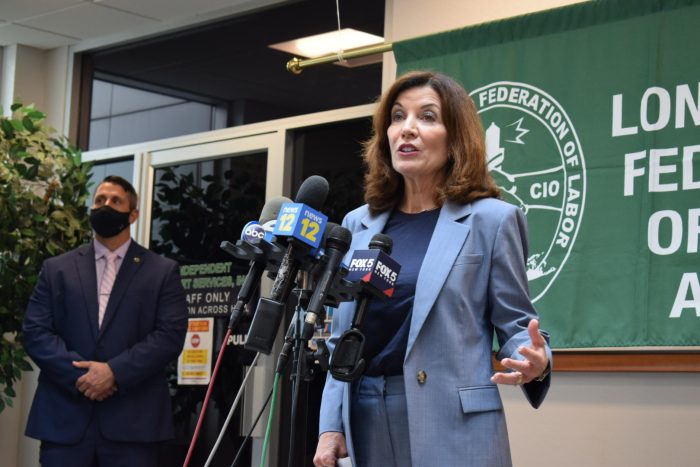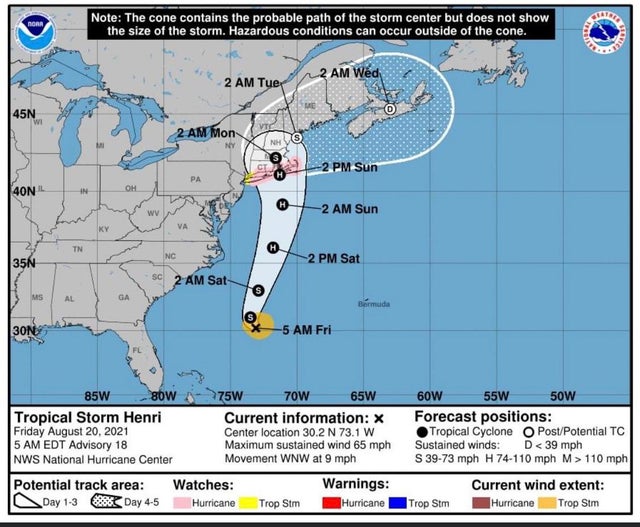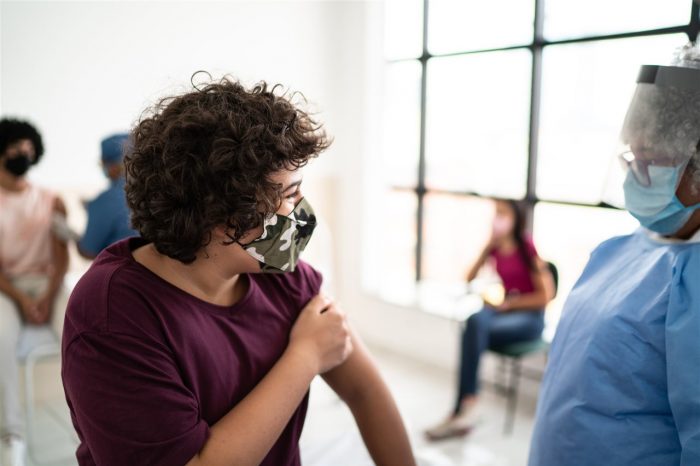Lt. Gov. Hochul makes a quick visit to Long Island
As Gov. Andrew Cuomo (D) packed up his moving trucks at the governor’s mansion, the soon-to-be governess headed to Long Island.
With just a few days left until she becomes New York’s first female governor, Lt. Gov. Kathy Hochul (D) made a quick stop in Hauppauge for a roundtable discussion with local labor leaders where topics included job training, green jobs and new legislative efforts to support essential workers.
Although the discussion was closed to media, Hochul made an appearance to quickly discuss her intentions during the meeting.
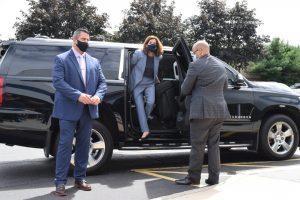
“One of my first priorities is continue creating good jobs,” she said. “Getting the offshore wind institute off the ground and give opportunities to just really train people in the underserved communities and the jobs of tomorrow where there will be tens of thousands of jobs in that space.”
Hochul said she and the business leaders in attendance also talked about workforce development and creating opportunities to keep young people fully employed on Long Island.
The visit wasn’t anything new, she said, mentioning that over the last seven years, “coming out and seeing the people is what I do.”
“If you ask anyone, I’ve been told that Nassau and Suffolk counties are planning on taxing me as a local resident because I’m here so often,” she joked.
As chair of the Regional Economic Development Councils, she said that she is going to continue and be accessible throughout her term.
“I’m going to continue showing appreciation to the labor community, the job creators, the business community and elected officials,” she said. “I have a deep appreciation for all the various roles of government, and I want them to know that they have a governor who recognizes and appreciates that.”
Hochul is set to take on her new role early Tuesday, Aug. 24 when she will move into the governor’s mansion.
“I haven’t thought about getting a U-Haul. I was just going to pack an overnight bag and see what happens,” Hochul joked. “I’ll then keep our residence in Buffalo as well. It’s going to be very fluid.”
When briefly asked about her policy surrounding the mask mandate, she said she will not be making an official statement until Tuesday but hinted that “people should be ready.”
SBU Hospital earns three stars in Vascular Quality Initiative Registry Participation Award program
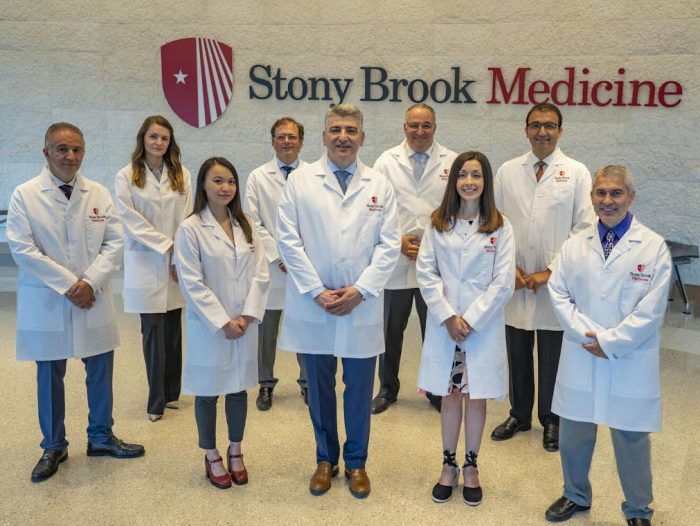
The Society for Vascular Surgery’s Vascular Quality Initiative (SVS VQI) has once again awarded Stony Brook University Hospital three stars for its active participation in the Registry Participation Program for 2020.
The mission of the SVS VQI is to improve patient safety and the quality of vascular care delivery by providing web-based collection, aggregation and analysis of clinical data submitted in registry format for all patients undergoing specific vascular treatments. The SVS VQI operates 14 vascular registries.
Apostolos K. Tassiopoulos, MD, FACS, Chief of the Vascular and Endovascular Surgery Division, Interim Chairman of the Department of Surgery at Stony Brook University Hospital and Director of the Stony Brook Vascular Center says over the past decade Stony Brook has successfully utilized SVS VQI data to improve patient care in our hospital.
“As the first institution in New York State to participate in the Vascular Quality Initiative, we are proud to achieve three-star level designation for the fifth time since 2015,” says Dr. Tassiopoulos. “This designation is the result of our commitment and dedication to providing the best care for our patients.”
The participation awards program began in 2015 to encourage active participation in the registries program and recognize the importance of that participation.
Participating centers can earn up to three stars based on actions that lead to better patient care, including:
- The completeness of long-term, follow-up reporting, based on the percentage of patients for whom they have at least nine months of follow-up data
-
Physician attendance at semi-annual meetings of a regional quality group
-
Initiation of quality improvement activities based on SVS VQI data
-
The number of vascular registries in which the center participates
SVS VQI’s registries contain demographic, clinical, procedural and outcomes data from more than 841,000 vascular procedures performed in over 800 centers in the U.S. and in Canada. Each record includes information from the patient’s initial hospitalization and at one-year follow-up.
The wealth of data allows centers and providers to compare their performance to regional and national benchmarks. All centers and providers receive biannual dashboards and regular performance reports, so they can use their data to support quality improvement initiatives.
Biannual regional meetings allow physicians of different specialties, nurses, data managers, quality officers and others to meet, share information and ideas, and learn from each other in a positive and supportive environment. Members have used SVS VQI data to significantly improve the delivery of vascular care at local, regional, and national levels, reducing complications and expenses.
“Hard-working, dedicated organizations such as Stony Brook University Hospital are key to the success of the vascular registries,” said SVS VQI Medical Director Dr. Jens Eldrup-Jorgensen. “The work we do to build and maintain the registries for researcher use is crucial to health and outcomes for vascular patients. Like the old saying says, ‘if you can’t measure it, you can’t improve it.’”
About Stony Brook University Hospital:
Stony Brook University Hospital (SBUH) is Long Island’s premier academic medical center. With 624 beds, SBUH serves as the region’s only tertiary care center and Regional Trauma Center, and is home to the Stony Brook University Heart Institute, Stony Brook University Cancer Center, Stony Brook Children’s Hospital and Stony Brook University Neurosciences Institute. SBUH also encompasses Suffolk County’s only Level 4 Regional Perinatal Center, state-designated AIDS Center, state-designated Comprehensive Psychiatric Emergency Program, state-designated Burn Center, the Christopher Pendergast ALS Center of Excellence, and Kidney Transplant Center. It is home of the nation’s first Pediatric Multiple Sclerosis Center. To learn more, visit www.stonybrookmedicine.edu/
About The Society for Vascular Surgery and the Vascular Quality Initiative:
Operating under the Society for Vascular Surgery, the Vascular Quality Initiative is composed of 14 registries containing demographic, clinical, procedural and outcomes data from more than 841,000 vascular procedures performed nationwide and in Canada. The mission of SVS VQI is to improve the quality, safety, effectiveness and cost of vascular healthcare.
PSEG Long Island prepares for Tropical Storm Henri
PSEG Long Island continues to monitor the impending storm. Tropical Storm Henri is intensifying to a Category 1 hurricane as it continues up the coast to Long Island. As of 8 a.m. today, the weather system is forecasted to bring heavy rains and high winds with peak gusts ranging from 30 to 35 mph in western areas and 50 to 65 mph on the east end of Long Island beginning Sunday morning. Given the potential intensity of the storm, some outages may last up to seven to 10 days. The eastern end of Long Island is expected to experience the most severe weather and impact.
PSEG Long Island is performing system checks and ensuring extra supplies are on hand, including poles and transformers preparing for potential outages.
“We continue to monitor the track of Tropical Storm Henri,” said Michael Sullivan, senior director of Transmission & Distribution at PSEG Long Island. “As the storm makes its way up the coast, employees are preparing for the possibility of high winds that can cause flying debris, and bring down trees and power lines. We encourage our customers to do the same at their homes and businesses.”
PSEG Long Island has personnel ready to respond safely and as quickly as possible throughout the storm. Additionally, more than 1,200 line workers, tree trimmers, surveyors and other utility personnel from both local and off-Island resources are being procured to work alongside PSEG Long Island’s highly trained line personnel.
In addition to having additional personnel and equipment at the ready, PSEG Long Island has strengthened the electric grid to better withstand extreme weather and allow for faster power restoration, including elevating a number of substations above flood level in preparation for this kind of severe weather.
PSEG Long Island’s employees have been working continuously for the past seven years to make the electric infrastructure more resilient to extreme weather. From storm hardening upgrades to ongoing enhanced tree maintenance, the company’s proactive work allows the system to better withstand extreme weather.
COVID-19-related storm processes have been adjusted to continue to keep the health and safety of employees and customers at the forefront, even during these unusual times.
As part of their physical distancing protocols, they ask that customers remain in their homes when crews are working nearby. If customers must speak with the crews, they ask that they practice responsible physical distancing and remain at least 6 feet away to ensure the health of everyone involved. For more information about how PSEG Long Island continues to live up to its commitments during the pandemic, please visit www.psegliny.com/covid19.
During this storm, if necessary, PSEG Long Island may use an enhancement to our outage communications process. With this enhancement, customers contacting the Call Center early in the storm will receive a message that personnel are assessing conditions, rather than an estimated time of restoration (ETR). This change will allow crews to assess storm impact before issuing ETRs, thereby increasing the accuracy of the ETR information being provided. For more information about this new process visit https://www.psegliny.com/outages/estimatedrestorationtimes.
Customers should prepare, be cautious and stay alert to their surroundings during and after storms. Review storm preparation tips at https://www.psegliny.com/safetyandreliability/stormsafety.
Stay connected:
- Download the PSEG Long Island mobile app to report an outage and receive information on restoration times, crew locations and more.
- To report and receive status updates via text, text OUT to PSEGLI (773454) or visit us online at www.psegliny.com/outages
- To report an outage or downed wire call PSEG Long Island’s 24-hour Electric Service number: 800-490-0075.
- Follow PSEG Long Island on Facebook and Twitter to report an outage and for updates before, during and after the storm
- View PSEG Long Island’s outage information across Long Island and the Rockaways online at https://mypowermap.psegliny.com
Local doctors discuss possible booster shots for COVID
After seeing enough cases of vaccinated people testing positive amid a surge in the Delta variant that has become the dominant strain of the virus in Suffolk County, local health officials support the federal government’s plan to provide booster doses eight months after the first course of vaccination.
Several studies have pointed to the benefit of boosters, highlighting how people who are vaccinated have lower antibody levels over time and are more susceptible to the highly transmissible Delta variant.
Centers for Disease Control and Prevention Director Rochelle Walensky and Food and Drug Administration Acting Commissioner Janet Woodcock said in a joint statement on Wednesday, Aug. 18, that the government is prepared to offer booster shots for all Americans beginning the week of Sept. 20 and starting eight months after people received their second shots.
A recent study by Mayo Clinic researchers looked at records for 25,0000 vaccinated and unvaccinated patients in Minnesota. The study showed 76% effectiveness in the Pfizer vaccine protecting them from infection, but 42% effectiveness in July during COVID, Sunil Dhuper, chief medical officer at St. Charles Hospital, explained in an email.
At the same time, Health Ministry of Israel data showed a similar progressive decline in the effectiveness of the vaccination in protecting patients from infection over a six-month period, particularly amid Delta variant surges.
Still, the vaccinations continued to provide protection against more serious forms of the disease, with a much smaller 10% decline in the effectiveness of vaccines in protecting people against hospitalizations, Dhuper said.
In physician practices, urgent care centers and emergency departments, doctors are seeing a “sizable number” of breakthrough cases, Dhuper continued.
Adrian Popp, chair of Infection Control at Huntington Hospital/ Northwell Health, said Huntington Hospital has seen breakthrough cases, although most of them are “mild” and are “diagnosed incidentally when patients get admitted for other issues.”
Dhuper urged residents to take precautions similar to the ones they took last year before vaccines were available, including social distancing, wearing masks and washing hands carefully, especially in indoor settings.
At this point, boosters will likely be available for the Pfizer/ BioNTech and Moderna vaccinations. The Food and Drug Administration is still looking at data for people who received the Johnson & Johnson shot.
Once the FDA provides Emergency Use Authorization for a booster for the general population, medical health experts anticipate a much smoother roll out than the initial struggle with finding vaccinations.
“As all who have been vaccinated in New York State have a [Centers for Disease Control and Prevention] vaccine card,” Sharon Nachman, chief of the Division of Pediatric Infectious Diseases at Stony Brook Children’s Hospital, said in an email, “It should be straightforward to each person to get a booster at the eight-month mark.”
At the same time, parents are focused on the timing and availability of vaccines for children under the age of 12. Results from the trial are “expected in December 2020,” wrote Popp.
Medical experts continue to urge residents to receive their shots.
“It is hoped that the booster will cut down on these infections and thus transmissions,” Nachman said.
State legislators weigh in on new governor, Kathy Hochul

After Gov. Andrew Cuomo (D) announced his resignation last week, Lt. Gov. Kathy Hochul (D) began to draw up plans to take over the role. Her first day in the governor’s chair will be Aug. 24.
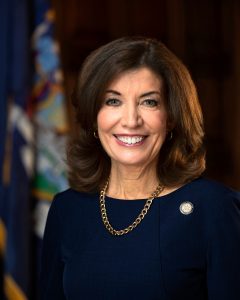
She was selected by Cuomo as his running mate as lieutenant governor in the 2014 New York gubernatorial election. Hochul, who began her career as an attorney, had served as a member of the Hamburg Town Board from 1994 to 2007, Erie County clerk from 2007 to 2011 and was congresswoman in the state’s 26th District from 2011 to 2013.
State senators and assemblymen in Suffolk County filled in TBR News Media on what they know about the first female governor.
State Sen. Jim Gaughran (D-Northport) in an email described her as “competent, experienced and absolutely ready to lead New York State forward.” Freshman senator, Mario Mattera (R-St. James), wrote in an email that he only had the opportunity to meet her briefly in the past but found her to be “cordial and approachable.”
State Assemblyman Mike Fitzpatrick (R-St. James) said in a phone interview he has met her a few times and said she is a nice person who he believes is capable of doing the job ahead of her. Assemblyman Steve Englebright (D-Setauket) described her as a hard worker who is warm and open to learning about what people think. He said in a phone interview that while he has never had any policy interaction with her, he has met her.
Both assemblymen said that Cuomo kept Hochul on the outside during his tenure. Despite the soon-to-be former governor not providing her with opportunities to demonstrate what she’s capable of, Englebright said he believes she has always known to be prepared to take on the position because she knew it was one of her responsibilities.
Gaughran and Englebright commended Hochul on getting out into the state to familiarize herself with constituents’ issues. Gaughran said he was confident that New Yorkers would like her.
“She has spent the past few years as lieutenant governor traveling the state and has tremendous knowledge about Long Island’s needs,” Gaughran wrote. “She has experience at every level of government — from local to state to federal — and will be able on day one to continue leading New York through the pandemic and the challenges posed by the Delta variant, as well as heal New York from this dark moment in history.”
Englebright echoed the sentiments.
“She knows New York and has traveled to every county in the state as basically an envoy of the executive chamber of goodwill,” Englebright said, adding her good listening skills she demonstrated during these trips will be an asset in the role.
Fitzpatrick said he believes Hochul has a hard time ahead though.
“I think Governor Hochul not only has a tough job, but I think she has a very difficult path to the nomination,” he said.
He added she will need to satisfy those who are progressives in the Democratic Party while also pleasing moderates.
“She’s in a difficult position,” he said.
Mattera agreed.
“She has a lot of work to do to overcome the issues that derailed the Cuomo administration, and I am sure the residents of New York will be keeping a keen eye on how she handles the last portion of Governor Cuomo’s term,” he said.
Englebright agreed she will be tested.
“But this is not her first rodeo,” he said. “She’s experienced so I think the state will be in good hands.”
Gaughran and Englebright, who both believe she has a good chance of winning in 2022, said if they were to give her advice they would tell her how important it is to have a good and cooperative relationship with the state Legislature. Something they felt Cuomo didn’t have. Mattera echoed the sentiment.
“There is a wealth of knowledge in the Senate and Assembly members since they closely represent those they serve in their respective districts,” Mattera said. “That can help our state move forward following this year’s crisis and the ongoing controversy surrounding Governor Cuomo and his administration.”
Editorial: Living together in peace
Many have asked what has happened to us as a society.
As we prepare to remember the victims of 9/11 in just a few weeks, we are reminded of a time 20 years ago when our communities came together to help each other. We applauded our first responders, offered our shoulders to those who were crying and all of us came together as one. The amount of empathy Americans, as well as those around the world, showed for the victims and their families was awe-inspiring. While 9/11 was a day to remember, 9/12 was just as important because it showed that we could be unified.
However, the tragedies and issues caused by COVID-19 have left us more divided than ever. Many scratch their heads wondering why people won’t follow the guidance of medical professionals, who last year simply asked us to wear masks and social distance while they figured out the best line of defense against the virus. Despite the significant strides made in medicine over the last few decades, a new form of a virus can still take time to figure out. And then this year, finally the vaccine that we all were waiting for was released, but yet many have refused to get it to help the common good and themselves.
It seems at times we have become selfish and self-absorbed, not worrying about anyone but ourselves. Then again, we shouldn’t be surprised. Look at our roads. More and more drivers engage in reckless driving, whether speeding down the road, weaving in and out of traffic, not pulling over for emergency vehicles or blowing through red lights and stop signs.
In the days of social media, we see too many people believing that their way is the only way and that those who think differently to them are evil or stupid to a point where we don’t respect our fellow citizens.
We have become so selfish and judgmental at times that we forget when we step out our door it’s no longer about us. The world does not revolve around one person, not even one family or social circle. As we navigate through the day, while our feelings and beliefs are valid and should be respected, the same goes for respecting others. We should also listen to each other. Really listen. It can be difficult at times to balance our wants and needs with the desires of others, but it’s the only way we can live together in peace.
Many have said they don’t want a new normal — they just want normal. Yet, it seems as if a new normal is needed, one where people’s actions show that they care about those around them.
It’s been said that learning about our history is important, so we don’t repeat the mistakes of past generations and benefit from the good elements, too. Now, let’s remember the tragic event of 9/11 and its aftermath in order to be reminded of how we united and moved forward during one of the most difficult times in American history.
We did it then and we can do it again — together.
D. None of the Above: Welcome to the COVID curriculum at Daniel Dunaief High School
By Daniel Dunaief

Welcome to Dan Dunaief HS or DDHS. I know it’s an odd time to start a new high school, but children need to learn, even during a pandemic.
Originally, I was planning to have everyone come to a pep rally on the first day of school. After all the restrictions of last year, it only seemed fitting to bring the kids together in the gym and celebrate the chance to sit in 1950s style wooden bleachers that rock when someone walks a few steps.
But, then, I realized we don’t have a basketball, football or squash team, we haven’t picked school colors, we don’t have a school song and, most importantly, we are in a difficult spot with the pandemic.
I know your kids are exhausted from dealing with the virus. Who can blame them? Aren’t we all?
At first, I thought we’d avoid the whole topic and stick to the basics in school.
But, then, it occurred to me that avoiding a virus that has now affected three school years wouldn’t make it better. We can try not to think about it, but that doesn’t make it go away. Information and knowledge will help these students understand the strange world that surrounds them and might empower them to feel as if they’re doing something about it, even if it’s just learning more about a time that future generations will no doubt study carefully, scrutinizing our every move as if we were some kind of early laboratory experiment.
With that in mind, I gave the curriculum serious consideration. I thought about all the standard ways students have learned.
Ultimately, I decided to turn toward the academic vortex. At DDHS, at least for the first year or so, we’re going to encourage students to study the real challenges of the world around them.
For starters, in our art class, we’re going to have design competitions for the front and back of masks. The winners will provide masks that the entire school will wear each week.
Then, in an engineering class, we’ll work on creating masks that are more comfortable and just as effective as the ones that make our faces sweat. Maybe this class can also figure out how to provide words that flash across the mask when we talk, giving people a better idea of what we’re saying behind our masks. Maybe enterprising students can design masks that cool our faces when we sweat and warm them when we’re cold, that shave or bleach unwanted hair or that act like dry-fit shirts, covering our faces without clinging to them.
In history, we’ll spend at least a semester on the Spanish Influenza. We’ll explore what leaders throughout the world did in 1918 during the last pandemic. We’ll see what worked best and what disappointed.
Our psychology class will devote itself to the conflicts between people’s perceptions of infringements on their individual freedoms and their desire to protect themselves and each other by wearing masks.
Our political science course will delve into how politics became enmeshed in the response to the virus. This class will look at which side gains, politically, amid different public health scenarios.
Science classes will explore why some people get incredibly sick from the virus, while others show no symptoms. We will also study the way the virus works, look at similar viruses and try to understand and track the development of variants.
Math will work with the science department to understand the spread of the virus and to plot various scenarios based on human behavior. Eager students in math will have the chance to demonstrate how sicknesses spread depending on the wearing of masks, the use of vaccines, and the creation of new variants.
Our language arts class will provide an outlet for students to express their hopes, dreams and concerns amid the unique challenges in their lifetime created by the pandemic.
Between You and Me: Water, water everywhere, but will we have enough to drink?
By Leah S. Dunaief

The other day, I went to the kitchen sink for some water, and when I turned on the faucet, only a few drops came out, then nothing. Puzzled, I tried it again, shutting then opening the tap. No water. My first thought was that something might be wrong with the pipes in the house. Zipping around, I tried the bathroom sinks. Same result. The water line into the house looked intact, no leaks. This was going to be a big problem, I worried, worse than when the electricity cuts out. I had an awful feeling of deprivation. Where was our water?
It turned out that there was a major leak in the underground water line to our block. Before too long, the Suffolk County Water Authority workers arrived and began digging up the blacktop. It was during those high heat days, and soon the men were drenched in their own sweat, but I admired their work ethic. They kept at the job for a full 12 hours until the line was repaired. We deeply appreciated them and let them know.
I also had a new perspective on having water. We turn the handle and expect to have water to drink, to cook, to clean, to bathe. Yes, I have traveled in other countries where I had to drink bottled water, but nonetheless, water came out of the taps. I follow the news about water shortages around the world, including in our country, but it is with a different perspective now when I see such reports on television. We feel entitled to running water, but we are so privileged. To turn on the faucet and have nothing come out, even for a few hours, is deeply unsettling.
Here is an example where water is a great concern. We know there has been a drought in California for the past two years. Southern California cities have prepared for the worst by building aqueducts and reservoirs and storing water underground. Despite their more arid climate, the south of the state is prepared. Smaller northern California towns, located in what was a more rainy climate, and much loved by tourists, are caught short. Reservoirs there are at worrisome levels and even power-generating dams have had to stop producing electricity because of insufficient water. These are agricultural areas too, and farmers, as well as restaurateurs and innkeepers, are afraid they may have to shut down. To truck in water costs 20 to 45 cents a gallon compared with the typical utility company rate of less than a penny a gallon.
Further, the level of water in the Colorado River and Lake Mead, which is formed by the Hoover Dam, is falling, threatening the water supply for Arizona, New Mexico and Nevada residents and especially Arizona’s agricultural output. Even major semiconductor manufacturers, expanding there, require a lot of water to produce their much needed product. Lake Mead, the country’s largest reservoir, is now at its lowest level ever. The $1 trillion package just passed by the Senate does include water shortage mitigation funds.
Worldwide, over a billion people lack access to water and 2.7 billion find water scarce for at least one month a year. Countries most affected include Egypt, Syria, Somalia, Pakistan, Haiti, Laos, Cambodia, Ethiopia and Afghanistan. The irony is that over 70 % of the earth is covered by water. Desalination, which is an expensive option, could become a solution. There is also water in the air. An Israeli company called, Watergen. pulls water from the air, as much as 6000 liters a day. that is used to support entire hospitals in Gaza and rural villages in central Africa. It also helped Australia battle bush fires in 2020. Further, harvesting the pure water from icebergs is big business along Canada’s east coast.
These are all possible solutions. Perhaps most important is the care we humans must take with our precious supply, not to mindlessly pollute or overuse what we are grateful to have. I am duly reminded how lucky we are.
Long Island Museum reopens Aug. 20 with three new exhibits
By Tara Mae
The Long Island Museum (LIM) in Stony Brook unveils three exciting new exhibitions — Tiffany Glass: Painting with Color and Light, Fire & Form: New Directions in Glass and the 8th annual LIMarts Members’ Exhibition, Fragile — this Friday, Aug. 20. All three will be on view through Dec. 19.
Art exhibit, Fragile, showcases work of LIMarts members

Peace may be found in both the practice and presence of art. Fragile explores how art enriches our lives, particularly during times of stress and strife. On display in the recently renovated Cowles Gallery in the History Museum and Visitors Center (pictured on the right), the show features works by 92 members of LIMarts, both amateur and professional, working in different formats and mediums including sculpture, printmaking, oil painting, watercolor, etc.
“LIMarts is a collaborative arts group designed for artists dedicated to creating a new forum within our cultural community,” said Neil Watson, Executive Director of the LIM. “The group offers space for the exhibition and sale of artwork, varied programming events, lectures and opportunities for social gathering with other artists and the public.”
All LIMarts members were invited to submit one piece for the exhibit, which enables the museum to introduce or amplify the art of local artists to its audience. Although a few of the artists have works already in the museum’s permanent collection, the art included in Fragile is being exhibited for the first time.
Thanks to a sponsorship by Maryellen and Michael Lubinsky, the museum was able to waive its normal commission; all proceeds from art sales will go directly to the artists.
There were no confines put on the artists’ interpretations of the theme, but they were constrained by space; each participant’s work had to fit on 12″ x 12″ canvas boards. This restriction enabled creative solutions and unique results.
“When everybody’s work is the same size, it distills a different type of beauty…they are all on the same panel and figuring it out,” said Joshua Ruff, Deputy Director of the LIM and the show’s curator. “The diversity of approaches and how the exhibit was interpreted are amazing: fragile, as an idea, departure point, and concept.”
During the past 19 months, emotional and physical fragility have been ideas arguably at the forefront of the collective conscience. Most of the submissions were created during this time frame, and these ideas are recurring subjects, especially as they relate to the delicate nature of both the environment and human condition. Yet fragile does not equal weak, and the exhibit is also a testament to how fragility can be infused with fortitude.
“This is not an exhibition of 92 different ways of suffering; rather it shows there is an inner reserve of strength in all of us. You can be vulnerable but have other positive qualities of strength. I think some of the artists were trying to say that you can be fragile but be strong or have a fragile environment that produces great beauty and great strength,” said Ruff.
Certain artists chose to explore the intersection of fragility and vulnerability by experimenting with new painting styles or artistic techniques. “Some artists were trying new things and you can be vulnerable when you are trying new things,” Ruff explained. “It’s really impressive to see how many ways people approached the subject and how many different points of view and perspectives you see.”
Tiffany Glass: Painting with Color and Light

Organized by the Neustadt Collection of Tiffany Glass in Queens, Tiffany Glass: Painting with Color and Light will be the first exhibition of its kind at the LIM. This compelling exhibition will include five windows, twenty lamps, and several displays showing how Louis C. Tiffany’s lamps were assembled, and how collectors today can distinguish between authentic lamps and forgeries.
The exhibition features some of the most celebrated of Tiffany’s works. Chosen for their masterful rendering of nature in flowers or landscape scenes, they exemplify the rich and varied glass palette, sensitive color selection, and intricacy of design that was characteristic of Tiffany’s leaded-glass objects. This exhibition also highlights some of the key figures at Tiffany Studios who made essential contributions to the artistry of the windows and lamps— chemist Arthur J. Nash and designers Agnes Northrop and Clara Driscoll.
Fire & Form: New Directions in Glass

Zynsky;
Heller
Gallery, NYC
Fire & Form: New Directions in Glass , organized by the Long Island Museum, will feature nearly 50 works from nine contemporary artists, all reinforcing that glass is a sculptural material of near-infinite artistic and narrative possibilities. The artists included in this exhibition represent some of the most renowned names in American contemporary glass: Joseph Cavalieri, Deborah Czeresko, Trefny Dix, Bengt Hokanson, Beth Lipman, Judith Schaechter, Andy Stenerson, Marianne Weil, and Toots Zynsky. These exceptional artists all demonstrate a variety of approaches, methods, and inspirational starting points. Fire & Form will inhabit more than 2,500 square feet in LIM’s History Museum and Visitor’s Center and will be accompanied by a richly illustrated 30-page catalogue that will be printed as a takeaway for visitors.
“Fire & Form and Tiffany Glass are two of the biggest and most beautiful exhibitions we have ever mounted here,” says Joshua Ruff, Deputy Director the LIM and one of the curators of Fire & Form. “The comparison between Tiffany’s approach with some of the striking other work people will see — modern stained glass, blown glass, and cast glass — will really give people some perspective on how versatile a medium it really is.
IF YOU GO
The Long Island Museum is located at 1200 Route 25A in Stony Brook. It is open Thursday to Sunday from noon to 5 p.m. Admission is $10 for adults, $7 for seniors (62 and older), $5 for students (including college students with IDs), $3.50 for people with disabilities (personal care assistants admitted for free), and free for children under the age of six. For more information about the above exhibits or orther programs at the LIM, call 631-751-0066 or visit longislandmuseum.org.


